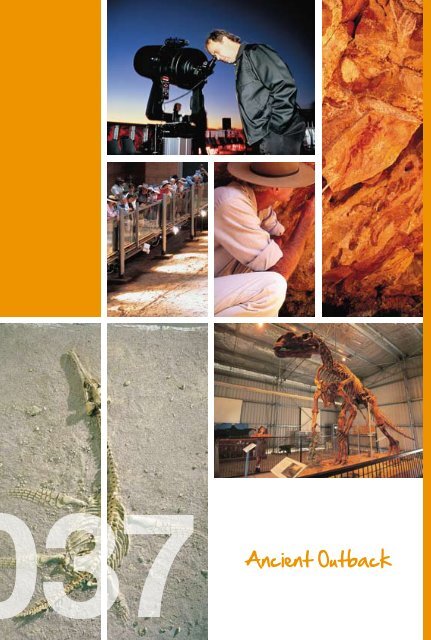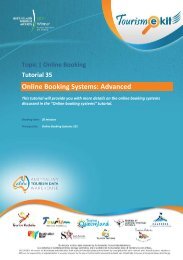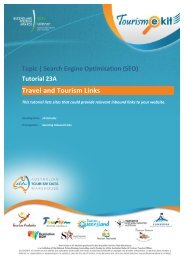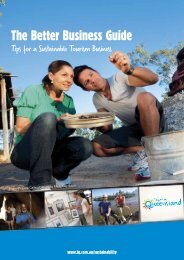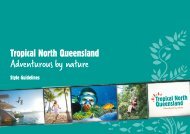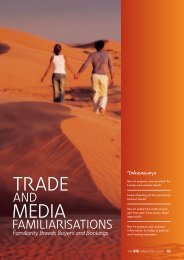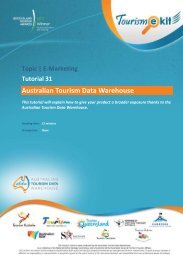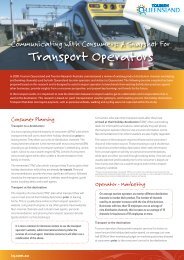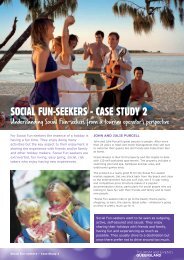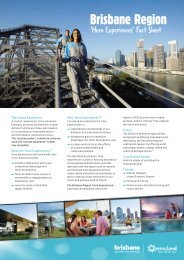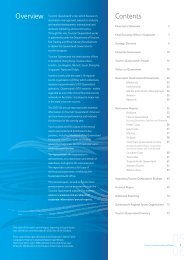Ancient Outback - Tourism Queensland
Ancient Outback - Tourism Queensland
Ancient Outback - Tourism Queensland
You also want an ePaper? Increase the reach of your titles
YUMPU automatically turns print PDFs into web optimized ePapers that Google loves.
37<br />
<strong>Ancient</strong> <strong>Outback</strong>
a<br />
t<br />
i<br />
i<br />
COEN<br />
l<br />
i<br />
e<br />
k<br />
i<br />
n<br />
i<br />
YARRADEN<br />
A R I A<br />
COOKTOWN<br />
P E N T<br />
LAKELAND<br />
C A R<br />
N<br />
i<br />
c<br />
BOODJAMULLA<br />
(LAWN HILL)<br />
NATIONAL PARK<br />
ADELS GROVE<br />
LAWN HILL GORGE<br />
L a w<br />
h<br />
n<br />
o<br />
s<br />
l<br />
G r<br />
471km to<br />
Tennant<br />
Creek<br />
N O R T H E R N T E R R I T O R Y<br />
o<br />
H i<br />
e<br />
Poeppel<br />
Corner<br />
l<br />
RIVERSLEIGH<br />
g<br />
n<br />
l<br />
o<br />
R i<br />
CAMOOWEAL<br />
URANDANGI<br />
038<br />
C<br />
r<br />
r<br />
y<br />
MARREE<br />
v<br />
e<br />
e<br />
R<br />
e<br />
k<br />
i<br />
90<br />
MORNINGTON<br />
ISLAND<br />
BURKETOWN<br />
DOOMADGEE<br />
77<br />
93<br />
TIRRANNA<br />
r<br />
v<br />
70<br />
e r<br />
G<br />
e<br />
o r g i<br />
SIMPSON DESERT<br />
NATIONAL PARK<br />
90<br />
CAMOOWEAL CAVES<br />
NATIONAL PARK<br />
112<br />
105<br />
DAJARRA<br />
115<br />
n<br />
BIRDSVILLE<br />
SOUTH WELLESLEY<br />
ISLANDS<br />
GREGORY<br />
DOWNS<br />
MOUNT<br />
ISA<br />
R i v e r<br />
BEDOURIE<br />
C o o<br />
p e r<br />
r e<br />
C<br />
WAGGABUNDI<br />
GUNPOWDER<br />
e k<br />
h h a r d<br />
L e i<br />
c<br />
KAJABBI<br />
BOULIA<br />
S O U T H<br />
A U S T R A L I A<br />
57<br />
129<br />
74<br />
118<br />
149<br />
87<br />
44<br />
R<br />
60<br />
v e r<br />
146<br />
90<br />
QUAMBY 43<br />
CLONCURRY<br />
119<br />
26<br />
DUCHESS<br />
MERTY MERTY<br />
G<br />
L<br />
U<br />
O F<br />
F<br />
KARUMBA<br />
229<br />
140<br />
LAKE<br />
MACHATTIE<br />
110<br />
192<br />
BURKE & WILLS<br />
JUNCTION<br />
o<br />
l<br />
C<br />
73<br />
244 53<br />
39<br />
164<br />
12<br />
191<br />
22<br />
58<br />
113<br />
168<br />
153<br />
101<br />
253<br />
n<br />
48<br />
c<br />
u r<br />
138<br />
105<br />
INNAMINCKA<br />
S<br />
McKINLAY<br />
209<br />
v e r<br />
r<br />
y<br />
BETOOTA<br />
m i t<br />
71<br />
R<br />
CAMERON<br />
CORNER<br />
h b u r n e<br />
NORMANTON<br />
N o r m a n<br />
MIDDLETON<br />
78<br />
KYNUNA<br />
COMBO<br />
WATERHOLE<br />
CONSERVATION<br />
PARK<br />
Haddon<br />
Corner<br />
R i v e r<br />
F l i n d e r s<br />
CROYDON<br />
JULIA<br />
CREEK 50 MAXWELTON<br />
D i a m a n t<br />
R i v e r<br />
i n a R<br />
NELIA 50<br />
WINDORAH<br />
NOCCUNDRA<br />
TIBOOBURRA<br />
E i n a s l e<br />
GEORGETOWN<br />
Q U E E N S L A N D<br />
235<br />
118<br />
<strong>Outback</strong> Education Handbook | <strong>Ancient</strong> <strong>Outback</strong><br />
85<br />
58 131<br />
61<br />
47<br />
77<br />
DIAMANTINA<br />
NATIONAL<br />
PARK<br />
109<br />
148<br />
112<br />
R i v e r<br />
164<br />
i v e r<br />
LARK<br />
QUARRY<br />
CONSERVATION<br />
PARK<br />
117<br />
C o o p<br />
266<br />
e r C<br />
r e e k<br />
G i l b e r t<br />
i g h<br />
R i v e r<br />
RICHMOND<br />
HUGHENDEN<br />
CORFIELD<br />
112<br />
STAMFORD<br />
WINTON<br />
STONEHENGE<br />
EROMANGA<br />
MUTTABURRA<br />
89<br />
OPALTON<br />
LONGREACH<br />
W i l s<br />
o n<br />
T h o<br />
JUNDAH<br />
i v e r<br />
R<br />
L y n d<br />
R i v e r<br />
R i v e r<br />
BLADENSBURG<br />
NATIONAL<br />
PARK 179<br />
LOCHERN<br />
NATIONAL<br />
PARK<br />
m s<br />
B a<br />
o n R<br />
r c o o<br />
WELFORD<br />
NATIONAL<br />
PARK<br />
Q U E E N S L A N D<br />
196<br />
191<br />
114<br />
110<br />
150<br />
84<br />
74<br />
103<br />
92<br />
148<br />
49<br />
51<br />
380<br />
144<br />
19<br />
159<br />
125<br />
18<br />
58<br />
50<br />
52<br />
93<br />
83<br />
67<br />
158<br />
69<br />
67<br />
MAREEBA<br />
83<br />
CAIRNS<br />
108<br />
GORDONVALE<br />
CHILLAGOE<br />
ATHERTON<br />
83<br />
MOUNT GARNET<br />
45<br />
88 INNISFAIL<br />
RAVENSHOE<br />
i v e r<br />
R i v e r<br />
M<br />
MOUNT<br />
SURPRISE<br />
BLACKBRAES<br />
NATIONAL<br />
PARK<br />
94<br />
89<br />
225<br />
151<br />
EMMET<br />
YARAKA<br />
QUILPIE<br />
WANAARING<br />
i<br />
t<br />
c h<br />
17<br />
64<br />
104<br />
o<br />
l<br />
B u<br />
e l<br />
o<br />
l<br />
i v e r<br />
R<br />
R<br />
UNDARA<br />
VOLCANIC<br />
NATIONAL<br />
PARK<br />
205<br />
37<br />
102<br />
52<br />
246<br />
v e<br />
i<br />
46<br />
TORRENS CREEK<br />
PRAIRIE<br />
ILFRACOMBE BARCALDINE<br />
JERICHO<br />
80<br />
ISISFORD<br />
MOSSMAN<br />
r<br />
THE LYND JUNCTION<br />
GREENVALE<br />
52<br />
ADAVALE<br />
TOOMPINE<br />
34<br />
PORT DOUGLAS<br />
ARAMAC<br />
TULLY<br />
BALFE’S<br />
CREEK<br />
HOMESTEAD<br />
BLACKALL<br />
CHARLEVILLE<br />
CHEEPIE<br />
88<br />
i v e<br />
R<br />
P a r o o<br />
r<br />
H<br />
e<br />
IDALIA<br />
NATIONAL<br />
PARK<br />
WYANDRA<br />
TAMBO<br />
r d<br />
48 COOLADDI<br />
99<br />
i v e r<br />
r b e<br />
PORCUPINE WHITE<br />
GORGE MOUNTAINS<br />
NATIONAL NATIONAL<br />
PARK PARK<br />
158<br />
PENTLAND<br />
43<br />
116<br />
27<br />
89<br />
76<br />
47<br />
85<br />
63<br />
112<br />
100<br />
101<br />
248<br />
114<br />
MOORRINYA<br />
NATIONAL<br />
PARK<br />
FOREST<br />
DEN<br />
NATIONAL<br />
PARK<br />
67<br />
22<br />
106<br />
209<br />
12<br />
r<br />
t<br />
R<br />
l<br />
A<br />
v e<br />
B u<br />
e<br />
c<br />
i<br />
r d<br />
W a<br />
r<br />
R<br />
R<br />
e<br />
v<br />
i<br />
R<br />
v<br />
r<br />
CARDWELL<br />
e<br />
INGHAM<br />
TOWNSVILLE<br />
r<br />
i v e r<br />
42<br />
AUGATHELLA<br />
C u<br />
CHARTERS<br />
TOWERS<br />
n d<br />
B e l y a<br />
87 53<br />
5<br />
55<br />
120 72<br />
98<br />
20<br />
23 25<br />
7<br />
THARGOMINDAH<br />
YOWAH CUNNAMULLA<br />
13<br />
104<br />
68<br />
LAKE BINDEGOLLY EULO<br />
NATIONAL PARK<br />
163<br />
122<br />
119<br />
CURRAWINYA<br />
NATIONAL<br />
PARK<br />
HUNGERFORD<br />
BARRINGUN<br />
79<br />
74<br />
108<br />
68<br />
217<br />
15<br />
187<br />
200<br />
101<br />
137<br />
o a<br />
l g<br />
R i<br />
o<br />
R i v<br />
v e r<br />
121<br />
119<br />
ALPHA<br />
MORANBAH<br />
BOWEN<br />
CLERMONT<br />
87 MORVEN<br />
44 MITCHELL 22<br />
TREGOLE<br />
NATIONAL MUNGALLALA 45 AMBY<br />
PARK<br />
177 BOLLON 113<br />
e r<br />
r i e<br />
B i r<br />
360<br />
r<br />
W a<br />
134<br />
r<br />
84 91<br />
16<br />
209<br />
R i v e r<br />
N e b i n e<br />
S<br />
e r<br />
R i v<br />
u<br />
e g o<br />
t<br />
i v e<br />
R<br />
LAKE DALRYMPLE<br />
t<br />
204<br />
r<br />
e<br />
HEBEL<br />
BREWARRINA<br />
r<br />
168<br />
R<br />
i<br />
v<br />
e<br />
r<br />
SALVATOR<br />
ROSA<br />
NATIONAL<br />
PARK<br />
210<br />
54<br />
LAKE<br />
MARABOON<br />
KA KA<br />
MUNDI<br />
NATIONAL<br />
PARK<br />
MT MOFFATT<br />
NATIONAL PARK<br />
109<br />
DIRRANBANDI<br />
66<br />
PROSERPINE<br />
CAPELLA<br />
52<br />
EMERALD<br />
67<br />
76<br />
SPRINGSURE<br />
210<br />
ROLLESTON<br />
CARNARVON<br />
GORGE<br />
NATIONAL<br />
PARK<br />
106<br />
281<br />
71<br />
40<br />
65 ROMA<br />
88<br />
BLACKWATER<br />
192<br />
INJUNE<br />
91<br />
SURAT<br />
MACKAY<br />
ST GEORGE<br />
NINDIGULLY<br />
203<br />
MUNGINDI<br />
P A C I F I C<br />
195<br />
O C<br />
141<br />
180<br />
E<br />
A N<br />
MOREE<br />
R<br />
1<br />
G
<strong>Ancient</strong> <strong>Outback</strong><br />
From the weather-worn crags of sun-drenched escarpments<br />
to the treasures buried beneath the dry bed of a long lost<br />
inland sea, <strong>Queensland</strong>’s <strong>Outback</strong> tells of a land before time.<br />
Rich in its diversity, the traces of Gondwana and 144 million<br />
years of evolution are clearly visible to the keen explorer.<br />
Scratch the surface and the bones of dinosaurs readily reveal<br />
the secrets of one such ancient epoch. Rock wall markings<br />
carry the stories of ancestral connections to the earth’s oldest<br />
surviving culture. And on a star-lit night it is simply mindblowing<br />
to look up and know this vast land is only one small<br />
part of the great glimmering cosmos above.<br />
15<br />
16<br />
17<br />
18<br />
19<br />
Aboriginal Heritage<br />
Powerful images portray land of The Dreaming....................040<br />
Cosmology<br />
Heaven’s above - What’s that star?......................................042<br />
Dinosaurs<br />
Earth gives up its long lost giants.........................................044<br />
Dinosaurs of Richmond<br />
Marine reptiles surface after 100 million years.......................046<br />
Lark Quarry<br />
Dinosaur panic thunders down through the ages.................048<br />
OCKHAMPTON<br />
96<br />
GLADSTONE<br />
BILOELA<br />
BANANA<br />
MIRIAM VALE<br />
TAROOM<br />
THEODORE<br />
MONTO<br />
EIDSVOLD<br />
GIN GIN<br />
GAYNDAH<br />
MUNDUBBERA<br />
BUNDABERG<br />
CHILDERS<br />
MARYBOROUGH<br />
GYMPIE<br />
MILES<br />
CHINCHILLA<br />
KINGAROY<br />
NAMBOUR<br />
127<br />
129<br />
113<br />
MOONIE<br />
DALBY<br />
84<br />
OAKEY<br />
PITTSWORTH<br />
TOOWOOMBA 122<br />
IPSWICH<br />
BRISBANE<br />
97<br />
MILMERRAN<br />
WARWICK<br />
TWEED HEADS<br />
INGLEWOOD<br />
OONDIWINDI<br />
123<br />
TEXAS<br />
TENTERFIELD<br />
LISMORE<br />
BALLINA<br />
<strong>Queensland</strong>’s <strong>Outback</strong> Education Handbook | <strong>Ancient</strong> <strong>Outback</strong> 039<br />
GRAFTON
15<br />
Powerful images portray<br />
land of The Dreaming<br />
Quirky fact :<br />
The skeletal frames of gunyahs (stick shelters)<br />
can still be found in <strong>Queensland</strong>’s <strong>Outback</strong>.<br />
Curriculum Information<br />
Year<br />
Learning and Assessment (Time, Continuity and Change/Culture and Identity)<br />
6 Aboriginal Culture - An <strong>Ancient</strong> Civilisation<br />
7 Combining Cultures - Defines Australia<br />
Description<br />
Australia’s Aboriginal heritage is one of the oldest in the world. Aboriginal people have occupied Australia<br />
from around 40,000 to 60,000 years ago. Prior to European arrival Aborigines lived in tribes and clans, their<br />
Country or territorial boundaries marked by geographical features of the area such as rivers and mountains.<br />
While sharing much in common, the land influenced each group’s distinct culture and heritage and gave rise to<br />
an extraordinary diversity among groups across the continent. For example, there were between 200 and 250<br />
spoken languages with more than 700 recorded dialects.<br />
Aboriginal people attribute their survival to living ‘as part of the land’ rather than ‘on the land’. This deep<br />
connection with the environment enabled them to observe and adapt to changing conditions. During the last<br />
60,000 years Australian Aborigines survived a major ice age and several other periods of climate change.<br />
All groups hunted and gathered their food, using tools fashioned from rocks, trees and plants. There was no<br />
written Aboriginal language. Traditions and histories were passed from one generation to the next through story<br />
telling, art and dance. Aborigines expressed art in many ways: through their dance and by painting their bodies<br />
to depict characters of The Dreaming, animals and events; through rock paintings, stencils and drawings; and<br />
as adornment to their instruments, tools and shields. They used ochre, a rock that is heavily enriched with iron<br />
oxide, to make paint. The ochre was ground into a powder and mixed with binding agents such as saliva, blood<br />
or animal fat. It was applied either by blowing it as a fine spray from the mouth, using a sharp or flattened end<br />
of a stick, or the fingers and hands. Another form of rock art involved engraving surfaces by pecking, grinding<br />
and abrading. Aboriginal art is often geometric. Circles, lines and dots were and still are commonly used along<br />
with figurative illustrations such as human and animal shapes, boomerangs and other tools, and animal tracks.<br />
Rock carving, Barcaldine<br />
Kronosaurus Korner, Richmond<br />
040<br />
<strong>Queensland</strong>’s <strong>Outback</strong> Education Handbook | <strong>Ancient</strong> <strong>Outback</strong>
History - Barcaldine<br />
First residents: Iningai, Wadjabangai, Iiba, Iningas, Jagalingu, Jirandali,<br />
Mootaburra, Pitjara, and Kuungkari peoples<br />
European exploration: Thomas Mitchell, 1846<br />
European settlement: 1863<br />
Town gazetted: 1886<br />
History highlights:<br />
n Site of the Great Shearers’ Strike, 1891<br />
n Birth place of the Australian Labor Party, 1891<br />
n Home of the Australian Workers Heritage Centre<br />
Classroom Activities<br />
n Find out about the Traditional Owners of land where you live/where<br />
your school and community is located<br />
n Invite an Aboriginal Elder from your community to speak to the class<br />
about their history<br />
n Discover what significant Aboriginal sites are located in your<br />
community or close by<br />
External Activities<br />
Visit Baloon Cave Aboriginal Cultural Trail at Carnarvon Gorge. This<br />
1km return (45 minutes) is a short walk to a small sandstone overhang<br />
featuring stencilled Aboriginal rock art. Signs along the trail introduce<br />
aspects of traditional use of the area’s resources. The Karingbal and<br />
Bidjara people welcome visitors to Carnarvon Gorge - ‘Carnarvon Gorge<br />
is our country. The spirit of our people is at home here. We welcome you<br />
to this place’.<br />
Best Experience<br />
Most historical Aboriginal sites are in protected areas with restricted<br />
access.<br />
Artesian Country Tours (departing from Barcaldine) offers guided tours<br />
to one of Australia’s oldest Dreamtime carving sites, lava blowholes,<br />
gorges, caves and desert springs.<br />
PO Box 232, Barcaldine QLD 4725<br />
Cost: Fees apply<br />
Hours: By appointment<br />
Contact: Tom Lockie<br />
Phone: (07) 4651 2211<br />
Email: tom@artesiancountrytours.com.au<br />
Website: www.artesiancountrytours.com.au<br />
Additional Resources<br />
Australian Institute of Aboriginal and<br />
Torres Strait Island Studies<br />
www.aiatsis.gov.au<br />
Australian Archaeological Association Inc.<br />
www.australianarchaeologicalassociation.com.au<br />
References<br />
Aboriginal and Torres Strait Islander<br />
Cultural Heritage Map of <strong>Queensland</strong><br />
Department of Natural Resources and Water<br />
www.nrw.qld.gov.au/cultural_heritage/<br />
Australian Government Department of the<br />
Environment, Water, Heritage and the Arts<br />
Culture and Recreation Portal<br />
www.cultureandrecreation.gov.au/articles/<br />
indigenous/<br />
Research School of Physical Sciences and<br />
Engineering, Australian National University<br />
The Last Ice Age in Australia<br />
http://cos.anu.edu.au/Resources/Posters/<br />
iceage.pdf<br />
Aboriginal Art Online<br />
www.aboriginalartonline.com/index.php<br />
<strong>Queensland</strong> Environmental Protection<br />
Agency - Parks and Forests<br />
www.epa.qld.gov.au/parks_and_forests/<br />
Further Information<br />
Wanpa-rda Matilda<br />
<strong>Outback</strong> Education Centre<br />
PO Box 26, Barcaldine QLD 4725<br />
Phone: (07) 4651 2530<br />
Email: the.principal@wanpardaeec.eq.edu.au<br />
www.wanpardaeec.eq.edu.au<br />
EPA Carnarvon Gorge (information centre)<br />
Carnarvon National Park,<br />
Via Rolleston QLD 4702<br />
Phone: (07) 4984 4505<br />
Open 8.00am - 5.00pm seven days a week<br />
www.epa.qld.gov.au/projects/park/index.<br />
cgi?parkid=49<br />
Mt Isa<br />
Longreach<br />
Townsville<br />
Rockhampton<br />
Charleville<br />
Brisbane<br />
<strong>Queensland</strong>’s <strong>Outback</strong> Education Handbook | <strong>Ancient</strong> <strong>Outback</strong> 041
16<br />
Heavens above - what’s that star?<br />
Quirky fact :<br />
Boodjamulla (Lawn Hill) National Park<br />
is actually a meteorite crater!<br />
Curriculum Information<br />
Year<br />
Learning and Assessment (Earth and Beyond)<br />
6 Gravitational Attraction - Planets of our Solar System in fixed orbits<br />
7 Changing Planets - Geological Evidence<br />
Description<br />
Stars are burning balls of gas that convert hydrogen to helium through nuclear explosions. Our sun is a star.<br />
Stars form in nebulae - interstellar clouds of dust, hydrogen gas and plasma. Nebulae are star-forming regions<br />
where gas, dust and other materials ‘clump’ together to form larger masses, which eventually become big<br />
enough to form stars. Nebula is the first stage of a star’s cycle.<br />
There are different types of nebulae, they include:<br />
n Diffuse nebulae - are extended and contain no clear boundaries.<br />
n Emission nebulae - contain ionised gas (mostly ionised hydrogen) that produces spectral line emission.<br />
n Reflection nebulae - do not produce visible light but reflect light from nearby stars.<br />
n Dark nebulae - seen as dark clouds in front of more distant stars or in front of emission nebulae.<br />
n Planetary nebulae - form from the gaseous shells ejected from low-mass stars when they transform into<br />
white dwarfs.<br />
n Supernova remnants - form from ‘shells’ of gas when a star collapses in on itself.<br />
There are also different types of stars:<br />
n Open or galactic star clusters - a group of a few to a few thousand stars formed from the same giant<br />
molecular cloud, and loosely gravitationally bound together.<br />
n Globular star clusters - a spherical collection of tens of thousands of stars that orbits a galactic core as a<br />
satellite. These clusters are very tightly bound by gravity, giving them spherical shapes.<br />
n Single stars - like our sun are in a minority. Most stars are<br />
doubles, triples or quadruples but to the human eye they<br />
appear as one star.<br />
n Binary star systems - are two stars that have a relationship<br />
with one another, orbiting around a central point of gravity.<br />
About 70 per cent of stars have a companion star.<br />
n Double stars - are two stars that appear together in the<br />
sky but it is a ‘chance’ alignment. The stars may be many<br />
billions of kilometres apart.<br />
Stars are also different colours depending on their<br />
temperature. While all stars are extremely hot at the core,<br />
their surface temperatures vary. Blue stars are extremely hot<br />
(12,000º - 40,000º Celsius), yellow stars like our sun are in<br />
the mid range (6,000º-12,000º Celsius) and red stars are the<br />
coolest (1,000º - 5,000º Celsius).<br />
Cosmos Centre - stargazing<br />
042<br />
<strong>Queensland</strong>’s <strong>Outback</strong> Education Handbook | <strong>Ancient</strong> <strong>Outback</strong>
History - Charleville<br />
First residents: Kunja, Wadjalang, Pitjara and Maranganji peoples<br />
European exploration: Edmund Kennedy,1847<br />
European settlement: 1860s<br />
Town gazetted: 1868<br />
History highlights:<br />
n Home to Cobb & Co.’s largest and longest running coach-making<br />
factory, 1890<br />
n First regular Qantas flights began from Charleville, 1922<br />
n <strong>Queensland</strong>’s first Steiger Vortex Rainmaking Gun introduced in 1902<br />
Classroom Activities<br />
n Create the solar system in your classroom<br />
n Find out quirky facts about planets in our solar system and how they<br />
got their names<br />
n Watch the Star Spangled Universe DVD<br />
External Activities<br />
Charleville, in <strong>Queensland</strong>’s <strong>Outback</strong>, is the ideal place on the planet to<br />
observe the Sagittarius arm of the Milky Way. The Cosmos Centre and<br />
Observatory offers nightly guided tours of the night sky using powerful<br />
Meade telescopes. By day an interactive display area contains movie<br />
presentations and interactive displays, plus a sun filter to enable visitors<br />
to view the sun through the telescopes.<br />
Best Experience<br />
Cosmos Centre and Observatory, Charleville<br />
Qantas Drive (off the Matilda Highway), Charleville QLD 4470<br />
Cost: Entry fee applies<br />
Hours: High Season (April - October) 1.00pm to 10.00pm<br />
Low Season (November - March) 1.00pm to 9.00pm<br />
Phone: (07) 4654 7771<br />
Email: cosmos@murweh.qld.gov.au<br />
Website: www.cosmoscentre.com<br />
Additional Resources<br />
South East <strong>Queensland</strong> Astronomical<br />
Society Inc<br />
www.seqas.org/Documents/Begin.pdf<br />
Education <strong>Queensland</strong><br />
New basics Project - Pi in the Sky<br />
www.education.qld.gov.au/corporate/<br />
newbasics/html/richtasks/year9/resourcesrt7.<br />
html<br />
<strong>Queensland</strong> Museum<br />
Inquiry Centre<br />
PO Box 3300, South Brisbane BC QLD 4101<br />
Phone: (07) 3840 7555<br />
Email: inquirycentre@qm.qld.gov.au<br />
Source: Earth and Space Program<br />
Australian Astronomy<br />
www.astronomy.org.au<br />
NASA<br />
www.nasa.gov<br />
References<br />
Students for the Exploration and<br />
Development of Space (SEDS)<br />
www.seds.org/MESSIER/more/mw.html<br />
www.seds.org/<br />
Sci-Tech Encyclopedia<br />
www.answers.com/topic/star-cluster<br />
Further Information<br />
Cosmos Centre and Observatory<br />
Qantas Drive, Charleville QLD 4470<br />
Phone: (07) 4654 7771<br />
Email: cosmos@murweh.qld.gov.au<br />
www.cosmoscentre.com<br />
Other Points of Interest<br />
n Save the Bilby Fund, Charleville<br />
n Land Management and Mulga Forest tours - Thurlby Station, Charleville<br />
n Myendetta Station, House of 100 Doors, Charleville<br />
Mt Isa<br />
Longreach<br />
Townsville<br />
Rockhampton<br />
Charleville<br />
Brisbane<br />
<strong>Queensland</strong>’s <strong>Outback</strong> Education Handbook | <strong>Ancient</strong> <strong>Outback</strong> 043
17<br />
Earth gives up its long lost giants<br />
Quirky fact :<br />
Muttaburrasaurus teeth were all replaced at the same time so the upper<br />
and lower jaws fitted together evenly. When its mouth was closed,<br />
the teeth came together like a pair of shears.<br />
Curriculum Information<br />
Year<br />
Learning and Assessment (Earth and Beyond)<br />
6 Laying down of History - Fossil Remains<br />
7 Investigating <strong>Ancient</strong> Australia - Palaeontologists at Work<br />
Description<br />
The discovery of dinosaur remains dates back to 1865 when James Sutherland unearthed an ichthyosaurus on the<br />
Flinders River. The pieces of vertebrae were sent to the Museum of Victoria where their discovery was briefly noted<br />
in 1867. While waiting on the museum’s findings, Sutherland continued to uncover a more complete specimen,<br />
including a skull and many more vertebrae. Again, these were sent to Melbourne for further study. Despite a second<br />
paper in 1869 describing the new material, it was not until 1984 that Dr Mary Wade of the <strong>Queensland</strong> Museum<br />
published the finding of two skulls present in the material. Other palaeontology discoveries in the area include:<br />
n 1888 - other ichthyosaur material described as Ichthyosaurus Marathonensis was found at Marathon<br />
Station, east of Richmond.<br />
n 1899 - a scrap of a large reptile jawbone was identified by the <strong>Queensland</strong> Museum as the giant plesiosaur<br />
Kronosaurus.<br />
n Some 40 kms outside Hughenden a pterosaur skull and jaw fragment were found.<br />
n 1962 - a Muttaburrasaurus was collected from many fragments in a cattle yard on the Thomson River near<br />
Muttaburra. Many pieces had been souvenired by locals, but a public appeal soon saw these handed in to<br />
the museum. Throughout the 80s there were several other Muttaburrasaurus finds around Hughenden, the<br />
most recent being in 1987 when Dr Mary Wade discovered a second Muttaburrasaurus skull.<br />
n 1989 - One of the world’s best examples of an ankylosaur was found by Ian and Rob Ievers on Marathon<br />
Station at Minmi Crossing East of Richmond. The Minmi find is more than 90 per cent complete.<br />
n 1989 - The most complete skeleton of a Cretaceous pliosaur was also discovered on Marathon Station.<br />
Sauropods<br />
Sauropods are very large plant-eating dinosaurs with long necks and tails. Since 1932, the fossil bones of<br />
several individual sauropods have been found in the Flinders region of <strong>Queensland</strong>. They probably belonged to<br />
Austrosaurus. The remains of an Austrosaurus Mckillopi were discovered by the McKillop family on Clutha Station<br />
west of Richmond, in 1932, and were dated to be 100 million years old. Half of a cervical (neck) vertebra from<br />
another sauropod was found near Hughenden. It is similar to the vertebra of Brachiosaurus, a huge sauropod with<br />
long forelegs found in Africa and North America. The <strong>Queensland</strong> animal is known as the ‘Hughenden sauropod’.<br />
The size of the bones found suggests an animal 20 - 22 metres long and perhaps weighing up to 50 tonnes. It<br />
used its long neck to reach the lower branches of the trees.<br />
Muttaburrasaurus<br />
Muttaburrasaurus Langdoni roamed the Australian landscape approximately 100 million years ago during the<br />
Cretaceous Period. This dinosaur is thought to have been quite common and four specimens have been found<br />
in central and northern <strong>Queensland</strong>. Muttaburrasaurus Langdoni was first discovered in 1963 by grazier Doug<br />
Langdon, whose property was in the Channel Country of the Thomson River just outside the town of Muttaburra.<br />
A museum team collected five tonnes of rock material from the site and transported it to Brisbane. It took many<br />
years of painstaking work to piece together the bones and the study of the animal is still not complete. The team<br />
has no real idea of the environment in which Muttaburrasaurus lived because all four specimens from <strong>Queensland</strong><br />
have been found in an area that was once covered by a vast inland sea.<br />
044<br />
<strong>Queensland</strong>’s <strong>Outback</strong> Education Handbook | <strong>Ancient</strong> <strong>Outback</strong>
History - Hughenden<br />
First residents: Dalleburra and Jirandali, Kutjala peoples<br />
European exploration:<br />
Lt Stokes, 1841<br />
European settlement: 1862<br />
Town gazetted: 1866<br />
History highlights:<br />
n First entire Muttaburrasauras dinosaur found in Australia, 1987<br />
n First Bracelet horse race ever run in Australia, 1886<br />
ClASSROOM ACTIVITIES<br />
n Create a paper-mâché dinosaur from the very earliest period when its<br />
bones were found<br />
n You are a Palaeontologist writing a letter to the local paper explaining<br />
the importance of the local fossils and the need for the return of the<br />
bones which the locals have souvenired<br />
n Produce a postcard which depicts the dinosaur fossils of the local area<br />
Best Experience<br />
Flinders Discovery Centre, Hughenden<br />
37 Gray Street, Hughenden QLD 4821<br />
Cost: Entry Fee applies<br />
Hours: Open daily from 9.00am to 5.00pm (December and January<br />
9.00am to 1.00pm) Closed some Public Holidays<br />
Phone: (07) 4741 1021<br />
Email: info@flinders.qld.gov.au<br />
Website: ww.hughenden.com<br />
Other Points of Interest<br />
n Kronosaurus Korner, Richmond<br />
n Lark Quarry Dinosaur Trackways, Winton<br />
n Riversleigh Fossil Fields, Boodjamulla (Lawn Hill) National Park<br />
Additional Resources<br />
<strong>Queensland</strong> Museum<br />
Phone: (07) 3840 7555<br />
Email: inquirycentre@qm.qld.gov.au<br />
www.qm.qld.gov.au/features/dinosaurs/<br />
South Australia Museum<br />
Fact sheet on Muttaburrasaurus<br />
www.samuseum.sa.gov.au/orig/pdf/dinosaurs.<br />
pdf<br />
ABC<br />
www.abc.net.au/dinosaurs/meet_the_dinos<br />
ABC - The Age of Reptiles<br />
www.abc.net.au/science/ozfossil/ageofreptiles/<br />
eromanga/kronosaurus.htm<br />
Australian Museum<br />
Research Library enquiries:<br />
Phone: (02) 9320 6152<br />
Scientific enquiries:<br />
Phone: (02) 9320 6202<br />
www.lostkingdoms.com/facts/index.<br />
cfm#cretaceous<br />
Australian Dinosaur Story<br />
Australian Government Department of the<br />
Environment and Heritage<br />
Email: heritage@environment.gov.au<br />
www.environment.gov.au/heritage/places/<br />
national/dinosaur-stampede/lark-quarry/larkquarry.html<br />
References<br />
Flinders Discovery Centre<br />
www.flinders.qld.gov.au<br />
<strong>Queensland</strong> Museum<br />
www.qm.qld.gov.au/features/dinosaurs/<br />
queensland/giants.asp<br />
Further Information<br />
Flinders Discovery Centre<br />
37 Gray Street<br />
Hughenden QLD 4821<br />
Phone: (07) 4741 1021<br />
Email: info@flinders.qld.gov.au<br />
www.hughenden.com<br />
Mt Isa<br />
Longreach<br />
Townsville<br />
Rockhampton<br />
Charleville<br />
Brisbane<br />
<strong>Queensland</strong>’s <strong>Outback</strong> Education Handbook | <strong>Ancient</strong> <strong>Outback</strong> 045
18<br />
Marine reptiles surface<br />
after 100 million years<br />
Quirky fact :<br />
The skull of a Kronosaurus can be<br />
up to 2.4 metres long!<br />
Curriculum Information<br />
Year<br />
Learning and Assessment (Earth and Beyond)<br />
6 <strong>Queensland</strong>’s Past - Geological Evidence<br />
7 100 Million Years of History - Identifying Fossils<br />
Description<br />
The Kronosaurus <strong>Queensland</strong>icus was a giant pliosaur - one of the largest marine reptiles ever known that lived<br />
in the vast inland sea that covered western <strong>Queensland</strong> between 110 and 100 million years ago.<br />
A ferocious hunter, the Kronosaurus is named after Kronos, the Greek god of time, who was so terrible that he<br />
ate his children. Kronosaurus is known from many specimens. It was between eight and 13 metres long, and<br />
had teeth were up to 25 centimetres long - the size of bananas. It roamed open oceans and the inland sea<br />
hunting ichthyosaurs, plesiosaurs, turtles and large fish, and was the most fierce and largest sea creature of<br />
its time. Kronosaurus has a skull up to 2.4 metres long. Kronosaurus swam through the water using its large<br />
flippers. It was not a particularly fast swimmer due to the size of its tail and body and it also had to surface<br />
regularly as it was an air-breathing marine reptile.<br />
To date, research has been unable to identify how the Kronosaurus reproduced. Most likely, they would have<br />
borne live young at sea, because the incredible size of the animal would have made it difficult to lay eggs on the<br />
shore. The ichthyosaur, another type of marine reptile alive at the time, had live births instead of laying eggs, so<br />
it is possible that Kronosaurus also made this adaptation to life in the ocean. Pliosaurs have no close relatives<br />
alive today.<br />
The first Kronosaurus <strong>Queensland</strong>icus was discovered in 1889 by A. Crombie and was noted in 1924.<br />
However, the best specimen to date was discovered at Army Down Station, north of Richmond, in the 1930s<br />
and the area is also the location of the largest pliosaur fossil finds.<br />
Richmond pliosaur<br />
In 1990, whilst mustering cattle on their property,<br />
Marathon Station, near Richmond in northwestern<br />
<strong>Queensland</strong>, graziers Rob and Ian Ievers<br />
discovered a whole and intact skeleton. This find<br />
was identified by the <strong>Queensland</strong> Museum as<br />
being a 100 million year old marine reptile, and<br />
later named the Richmond pliosaur.<br />
The skeleton (not a dinosaur) is one of the best,<br />
most complete skeletons of its type in the world.<br />
The animal is as yet un-named, but scientists<br />
are currently working to fully understand and<br />
describe it. It belongs to the pliosauroid group,<br />
and was likely a member of the polycotylid<br />
family, a specialised pliosuaroid from the Early<br />
Cretaceous Period. At nearly 5m long, it had a<br />
relatively short neck, powerful set of flippers and<br />
a tail. It lived in the inland sea in <strong>Queensland</strong> 100<br />
million years ago.<br />
Kronosaurus Korner, Richmond<br />
046<br />
<strong>Queensland</strong>’s <strong>Outback</strong> Education Handbook | <strong>Ancient</strong> <strong>Outback</strong>
History - Richmond<br />
First residents: Oonoomurra, Mitjamba, Wanam and Jirandali peoples<br />
European exploration: William Landsborough, 1862<br />
European settlement: 1862<br />
Town gazetted: 1882<br />
History highlights:<br />
n A service town to gold miners working the Woolgar Gold Field, 1880<br />
n Discovery of the first Kronosaurus <strong>Queensland</strong>icus,1924<br />
CLASSROOM ACTIVITIES<br />
n Using all the key elements of the text create a crossword puzzle to be<br />
used by a class group<br />
n Create a clay model which looks like a fossil from this period<br />
n Develop a pictorial time line to represent this period<br />
Best Experience<br />
Kronosaurus Korner<br />
91-93 Goldring Street, Richmond QLD 4822<br />
Cost: Entry fee applies. Self-paced and self-guided tours are<br />
available<br />
Hours: Open daily from 8.30am to 4.45pm<br />
Phone: (07) 4741 3429<br />
Email: enquiries@kronosauruskorner.com.au<br />
Website: www.kronosauruskorner.com.au<br />
Other Points of Interest<br />
n Flinders Discovery Centre, Hughenden<br />
n Lark Quarry Dinosaur Trackways, Winton<br />
n Riversleigh Fossil Fields, Boodjamullla (Lawn Hill) National Park<br />
n Australian Age of Dinosaurs, Winton<br />
Additional Resources<br />
Australian Museum<br />
Research Library enquiries:<br />
Phone: (02) 9320 6152<br />
Scientific enquiries:<br />
Phone: (02) 9320 6202<br />
www.lostkingdoms.com/facts/index.<br />
cfm#cretaceous<br />
<strong>Queensland</strong> Museum<br />
Phone: (07) 3840 7555<br />
Email: inquirycentre@qm.qld.gov.au<br />
www.qm.qld.gov.au/features/dinosaurs/<br />
Earth Science Australia<br />
www.earthsci.org/index.html<br />
ABC - The Age of Reptiles<br />
www.abc.net.au/science/ozfossil/ageofreptiles/<br />
eromanga/kronosaurus.htm<br />
References<br />
<strong>Queensland</strong> Museum<br />
www.qm.qld.gov.au/features/dinosaurs/<br />
queensland/giants.asp<br />
Australian Museum<br />
www.lostkingdoms.com/facts/index.<br />
cfm#cretaceous<br />
Richmond Shire Council<br />
www.richmond.qld.gov.au<br />
ABC - The Age of Reptiles<br />
www.abc.net.au/science/ozfossil/ageofreptiles/<br />
eromanga/kronosaurus.htm<br />
Further Information<br />
Kronosaurus Korner & Visitor<br />
Information Centre<br />
91-93 Goldring Street, Richmond QLD 4822<br />
Phone: (07) 4741 3429<br />
Email: enquiries@kronosauruskorner.com.au<br />
www.kronosauruskorner.com.au<br />
Richmond Shire Council<br />
50 Goldring Street<br />
PO Box 18, Richmond QLD 4822<br />
Phone: (07) 4741 3277<br />
Email: enquiries@richmond.qld.gov.au<br />
www.richmond.qld.gov.au<br />
Mt Isa<br />
Longreach<br />
Townsville<br />
Rockhampton<br />
Charleville<br />
Brisbane<br />
<strong>Queensland</strong>’s <strong>Outback</strong> Education Handbook | <strong>Ancient</strong> <strong>Outback</strong> 047
19<br />
Dinosaur panic thunders down<br />
through the ages<br />
Quirky fact :<br />
All up the tracks of 150 individual dinosaur<br />
were mapped at Lark Quarry!<br />
Curriculum Information<br />
Year<br />
Learning and Assessment (Earth and Beyond)<br />
6 Fossilised Footprints - <strong>Ancient</strong> History<br />
7 Primeval Landscape - A Place to Explore<br />
Description<br />
Lark Quarry Dinosaur Trackways is the site of perfectly preserved fossilised footprints of a dinosaur stampede.<br />
The 3000 footprints, commonly known as the ‘Trackways’, are thought to have occurred 95 million years ago<br />
during the mid Cretaceous Period. At that time Lark Quarry was part of a great river plain, with sandy channels,<br />
swamps and lakes brimming with freshwater mussels, lungfish and crocodiles. Rainfall was over one metre per<br />
year, so the surrounding lowland forest was lush and green.<br />
Local station manager Glen Seymour first discovered the Dinosaur Trackways in the 1960s. He thought they<br />
were fossilised bird tracks, and showed them to local enthusiast Peter Knowles. What they were looking at<br />
was, and still is today, the world’s only recorded evidence of a dinosaur stampede.<br />
On the day the drama unfolded, herds of small two-legged dinosaurs came to drink at the lake. There were at<br />
least 150 dinosaurs of two different kinds - carnivorous coelurosaurs about the size of chickens, and slightly<br />
larger plant-eating ornithopods, some of them as large as emus. A huge meat-eating theropod, smaller than<br />
a Tyrannosaurus, approached the lake. It slowed, saw the other dinosaurs gathered at the water’s edge and<br />
began to stalk, then turned and charged. The stampeding herd of smaller dinosaurs left a chaotic mass of<br />
footprints in the mud as they ran to escape.<br />
The site where the dinosaur footprints were found was once a streambed leading into a lake. The water level had<br />
dropped, exposing mudflats. When the dinosaurs stampeded, they left footprints in the half dried and still plastic<br />
mud. Sun, wind and rain would normally destroy tracks like this. But just a few days after the footprints were<br />
made, it began to rain and the lake rose gently, covering the tracks with sandy sediments before the mud had<br />
dried enough to crack. The next flood buried them below a metre of sand and a metre of mud. Over time, more<br />
sediment was laid down and as millions of years passed the sediment layers were compressed to form rock.<br />
Lark Quarry<br />
Lark Quarry Dinosaur Trackways - Walkway<br />
048<br />
<strong>Queensland</strong>’s <strong>Outback</strong> Education Handbook | <strong>Ancient</strong> <strong>Outback</strong>
History - Winton<br />
First residents: Koa, Malintji and Maiawali people<br />
European exploration: Ludwig Leichhardt, 1848<br />
European settlement: 1866<br />
Town gazetted: 1879<br />
History Highlights:<br />
n Opals discovered at Opalton in 1888 - the oldest opal mining venture<br />
in Australia<br />
n Site of Lark Quarry Dinosaur Trackways, the world’s only evidence of a<br />
dinosaur stampede<br />
n Home of the 20-30 tonne sauropod Elliot, discovered in 1999. It was<br />
until recently known as Australia’s largest dinosaur skeleton<br />
Classroom Activities<br />
n Explore the social, environmental and economic impact of Lark Quarry<br />
on the local area and its surrounds<br />
n Investigate and identify an action plan that would ensure Lark Quarry<br />
Dinosaur Trackways remain intact<br />
n After researching the subject, generate a class debate on the<br />
importance or otherwise of the Lark Quarry Dinosaur Trackways<br />
Best Experience<br />
Lark Quarry Dinosaur Trackways, via Winton<br />
Lark Quarry Conservation Park, Jundah Road, via Winton QLD 4735<br />
Cost: Entry fee applies<br />
Hours: Fully guided tours are available and Lark Quarry Dinosaur<br />
Trackways is open most days of the year<br />
Phone: 1300 665 115 or (07) 4657 1466<br />
Email: vic@matildacentre.com.au<br />
Website: www.dinosaurtrackways.com.au<br />
Other Points of Interest<br />
n Flinders Discovery Centre, Hughenden<br />
n Kronosaurus Korner, Richmond<br />
n Riversleigh Fossil Fields at Boodjamulla (Lawn Hill) National Park<br />
n Australian Age of Dinosaurs, Winton<br />
Additional Resources<br />
Australian Age of Dinosaurs<br />
PO Box 408, Winton QLD 4735<br />
Phone: (07) 4657 0414<br />
Email:info@australianageofdinosaurs.com<br />
www.australianageofdinosaurs.com<br />
University of <strong>Queensland</strong><br />
Palaeontology Department<br />
Steve Salisbury’s Vertebrate Palaeontology &<br />
Biomechanics Lab<br />
www.uq.edu.au/dinosaurs<br />
<strong>Queensland</strong> Museum<br />
Phone: (07) 3840 7555<br />
Email: inquirycentre@qm.qld.gov.au<br />
www.qmuseum.qld.gov.au<br />
South Australia Museum<br />
www.samuseum.sa.gov.au/pdf/dinosaurs<br />
Questacon<br />
www.questacon.edu.au/html/terrorsaurus<br />
ABC<br />
www.abc.net.au/dinosaurs/meet_the_dinos<br />
Dinosaur database<br />
www.arts-letters.com/dino2/ency<br />
Dinosaur encyclopedia<br />
www.isgs.uiuc.edu/dinos/de_4<br />
www.search4dinosaurs.com/pictures<br />
Australian Dinosaur Story<br />
Australian Government Department of the<br />
Environment and Heritage<br />
Email: heritage@environment.gov.au<br />
www.environment.gov.au/heritage/places/<br />
national/dinosaur-stampede/lark-quarry/larkquarry.html<br />
Australian Museum<br />
Research Library enquiries:<br />
Phone: (02) 9320 6152<br />
Scientific enquiries:<br />
Phone: (02) 9320 6202<br />
www.lostkingdoms.com/facts/index.<br />
cfm#cretaceous<br />
Earth Science Australia<br />
www.earthsci.org<br />
References<br />
Encyclopedia of dinosaurs San Diego:<br />
Academic Press,1997<br />
Lark Quarry Conservation Park<br />
www.dinosaurtrackways.com.au<br />
Further Information<br />
<strong>Tourism</strong> Development Officer<br />
Winton Shire Council<br />
PO Box 288, Winton QLD 4735<br />
Phone: 1300 665 115 or (07) 4657 1188<br />
Email: vic@matildacentre.com.au<br />
Mt Isa<br />
Longreach<br />
Townsville<br />
Rockhampton<br />
Charleville<br />
Brisbane<br />
<strong>Queensland</strong>’s <strong>Outback</strong> Education Handbook | <strong>Ancient</strong> <strong>Outback</strong> 049
............................................................................................................................................................................<br />
............................................................................................................................................................................<br />
............................................................................................................................................................................<br />
............................................................................................................................................................................<br />
............................................................................................................................................................................<br />
............................................................................................................................................................................<br />
............................................................................................................................................................................<br />
............................................................................................................................................................................<br />
............................................................................................................................................................................<br />
............................................................................................................................................................................<br />
............................................................................................................................................................................<br />
............................................................................................................................................................................<br />
............................................................................................................................................................................<br />
Notes<br />
............................................................................................................................................................................<br />
............................................................................................................................................................................<br />
............................................................................................................................................................................<br />
............................................................................................................................................................................<br />
............................................................................................................................................................................<br />
............................................................................................................................................................................<br />
............................................................................................................................................................................<br />
............................................................................................................................................................................<br />
............................................................................................................................................................................<br />
............................................................................................................................................................................<br />
............................................................................................................................................................................<br />
............................................................................................................................................................................<br />
............................................................................................................................................................................<br />
050<br />
<strong>Queensland</strong>’s <strong>Outback</strong> Education Handbook | <strong>Ancient</strong> <strong>Outback</strong>


